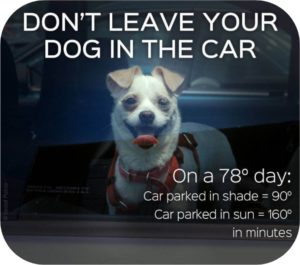The Dangers of Leaving Your Dog in the Car
Taking a drive with your canine friend on a summer’s day sounds like fun, but you should think twice about leaving him or her in your parked car. Most pet owners aren’t aware of the dangers of leaving their dogs inside a vehicle, especially when it’s hot outside. According to the American Veterinary Medical Association (AVMA), the temperature inside your car can rise almost 20 degrees in just 10 minutes, and cracking the windows does not make a difference. Leaving your dog in a car, even for a few minutes, can create a very dangerous or even deadly situation. Read on to learn everything you need to know about leaving your pet in a car and what to do if you see an animal confined in a vehicle under extreme conditions.
Why It’s so Dangerous
Cars essentially become mobile ovens in warm weather. While humans have sweat glands throughout their bodies that help keep them cool, canines rely on panting and can sweat only on areas not covered by fur, such as their paw pads and nose, to regulate temperature. According to PETA , if a dog gets excessively hot, it can suffer brain damage or perish from heatstroke in as little as 15 minutes.
 Certain pets are more at risk for developing heatstroke than others. For example, short-snouted canines such as bulldogs, boxers and pugs can have difficulty breathing in the heat. Pets with cardiac or respiratory conditions or other health problems may struggle with regulating their body temperatures in high heat. Dogs that are overweight or have dense coats also are more sensitive to higher temperatures.
Certain pets are more at risk for developing heatstroke than others. For example, short-snouted canines such as bulldogs, boxers and pugs can have difficulty breathing in the heat. Pets with cardiac or respiratory conditions or other health problems may struggle with regulating their body temperatures in high heat. Dogs that are overweight or have dense coats also are more sensitive to higher temperatures.
Watch for the Warning Signs
If your pet is exposed to high temperatures, look for signs of heat stress, which can develop quickly. Half of all dogs that go on to develop heatstroke can perish from it, generally in the first 24 hours, despite veterinary treatment. So, it’s vital to recognize the early signs of this condition, including:
· Panting
· Staggering gait
· Increased salivation
· Bright pink gums
· Rapid pulse
· Glazed eyes
· Vomiting
· A deep red or purple tongue
What to Do If Your Dog Shows Signs of Heat Stress
If your dog is showing any of the above symptoms, it’s imperative to get him or her to a cooler location. If possible, drape your dog with cool, damp towels or immerse him or her in a tub of cool water in order to gradually bring down the animal’s body temperature. It’s essential to begin the cooling process before you take the affected dog to the veterinarian, but do not use ice water because it will constrict the dog’s blood vessels and impair proper heat dissipation. Offer your dog fresh, cool water and make sure it drinks slowly.
 What If You See a Pet Inside a Hot Car?
What If You See a Pet Inside a Hot Car?
It only takes minutes to help save a life. If you come across a distressed animal stuck inside a parked vehicle on a warm day, the first step is to call the non-emergency number of your local police or animal control center and relay the car’s location, make, model and license plate number. Try to locate the owner by entering the nearest store or business and requesting that an emergency announcement be made about a pet left in a hot car. Go back and wait with the pet until help arrives. If you break a window to free the animal, the owner may be able to hold you liable for damages to his or her vehicle. In some states, good Samaritans can legally remove animals from vehicles under certain circumstances, so it’s important to be informed of the laws in your area.
Is It a Crime?
The criminality of leaving a pet in a hot car varies by state, with punishment ranging from a small fine to a misdemeanor or jail time. About 15 states enacted laws that allow any person, whether law enforcement or a good Samaritan, to rescue distressed animals left under dangerous conditions. According to the Animal Legal and Historical Center, 31 states have laws that either prohibit leaving an animal in a confined car under dangerous conditions or provide civil immunity for a person who rescues a distressed animal from a vehicle.
Ways You Can Help
Educate yourself on local and state laws concerning pets left inside hot cars and, if none exist, contact your local representatives or attend a town hall meeting to lobby for one. Spread the word to help inform pet owners and the public about the dangers of canine heatstroke. Keep your pet safe during the summer heat by leaving him or her at home — the dangers of heatstroke far outweigh the pleasure of taking your furry friend along for a ride or to run errands.
Author bio: Stephanie N. Blahut is Director of Digital Marketing and Technology for Figo Pet Insurance.


